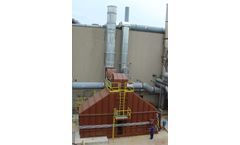Heat Exchanger Process Articles & Analysis
15 articles found
As we continue to innovate and adopt cleaner energy technology, renewable energy technologies are increasingly vital in our quest for sustainable and efficient energy solutions. Among these technologies, coil heat exchangers play a crucial role in enhancing the performance and efficiency of systems like geothermal heat pumps (GHPs) and solar thermal ...
As we continue to innovate and adopt cleaner energy technology, renewable energy technologies are increasingly vital in our quest for sustainable and efficient energy solutions. Among these technologies, coil heat exchangers play a crucial role in enhancing the performance and efficiency of systems like geothermal heat pumps (GHPs) and solar thermal systems. ...
All but the most basic heat exchangers are created to a bespoke brief, designed to take into account the material/s being heated or cooled, the heating or cooling medium, the amount of product being processed, product velocity, risk of fouling and a host of other factors. ...
Econotherm GW 1200 finned to finned pipe heat exchanger. 1.2MW process water heater (Genset). Remote location: chosen for high reliability, no single point of failure, low fouling,easy cleaning and low maintenance, small footprint and weight ...
The lower conveyor belt, after heat exchange with the thermal drying circulating air, becomes dry sludge and then discharges the drying machine through the discharging device. The final drying degree of the sludge can be adjusted according to the requirements to achieve semi-drying or full drying. The hot air circulation heat ...
Retain more process fluids, save time and budget on maintenance, increase heat transfer efficiency by up to 50%, and integrate into your existing system, or upgrade to a new skid-mounted heater exchange ...
While heat treatment is important in ensuring the safety of apple juice through pasteurisation or sterilisation, for some products heat plays an important role in the production process itself. ...
Heat exchangers which employ heat recovery or regeneration should not be confused with ‘regenerative heat exchangers,’ which are a specific type of heat exchanger. What we mean by heat regeneration at HRS is the recovery of as much surplus ...
In every situation where a heat exchanger is required, the combination of products and service fluids, application, temperature and other variables will be different. Understanding these properties ensures the correct heat exchanger is supplied. For example, high fouling materials may require a scraped-surface unit. Having ...
Design and construction plays a key role in achieving this, and the heat exchangers used for processes such as pasteurisation and sterilisation are no exception. There are three main elements to preventing contamination occurring in tubular heat exchangers: production quality, system design, and system ...
Exhaust heat from energy consuming processes and exhaust stacks is returned through a metal heat exchanger it as process air, preheated combustion air or plant comfort heat. The critical design factors for any energy recovery product is the airflow rate, temperature of the air stream, ...
A primary component to the production of xylene is the isolation and purification of the chemical from a complex mixture of petroleum hydrocarbons. Steam based heat exchangers are used to process the xylene. Inherent to the design and rough duty heat exchangers face during their operation, leaks can and do ...
The deposition of material on heat transfer surfaces is called fouling which significantly impacts on the thermal and mechanical performance of heat exchangers. Fouling increases the overall thermal resistance and lowers the overall heat transfer coefficient of heat exchangers as well as impeding ...
A process for converting Compressed Natural Gas (CNG) to Liquefied Natural Gas (LNG) is modelled thermodynamically and effects of design and operating parameters on exergy destruction and performance of the process are studied. ...
With the concentration of hydrocarbons in the process air stream, the heat energy content of the VOCs was self-sustained and the oxidation process required no additional fuel for destruction. RTO technology utilizes ceramic media in two or more beds as a high-efficiency heat exchanger. Process ...













